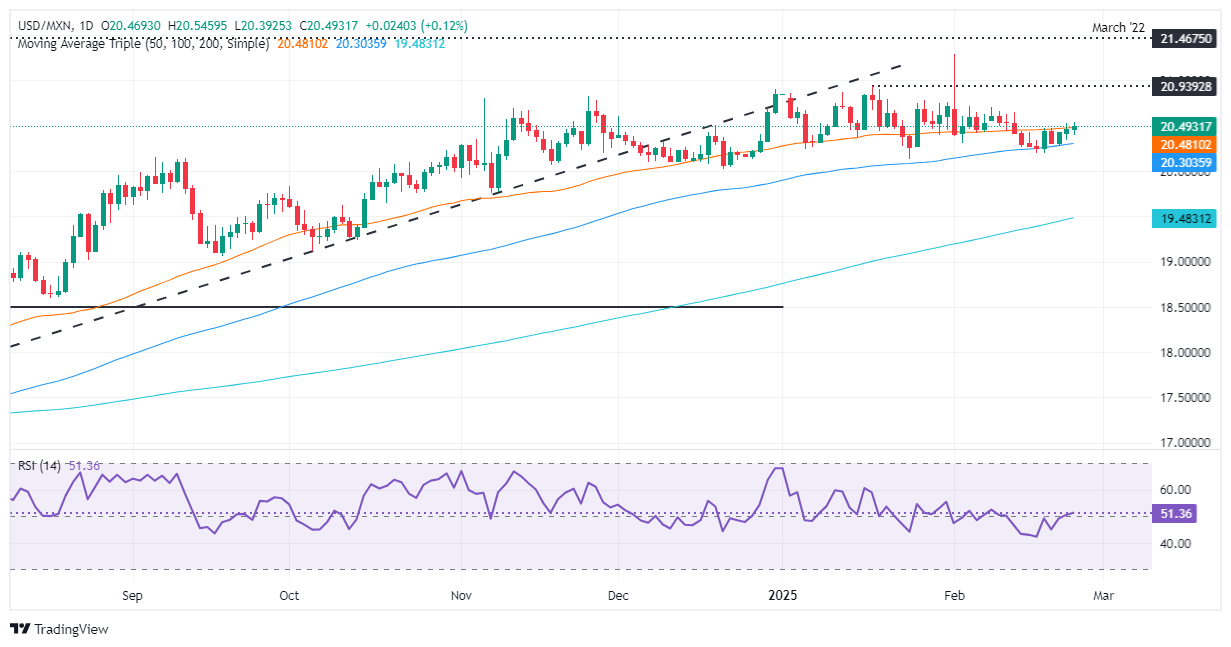Products You May Like
- Mexican Peso steadies as market sentiment remains bearish on trade risks.
- Trump confirms tariffs on Mexico are moving forward, pressuring the Peso.
- Banxico signals further 50 bps rate cuts as inflation nears the 3% target.
- US-Mexico trade talks continue, with a potential breakthrough expected Friday.
The Mexican Peso (MXN) recovers from earlier losses and turns flat against the Greenback as market sentiment shifts sour due to United States (US) President Donald Trump’s reiterating that tariffs on Mexico are on schedule. At the time of writing, USD/MXN trades at 20.4, virtually unchanged.
Geopolitics hurt the prospects of the Peso, which began Tuesday’s session positively but has lost ground. Late on Monday, US President Trump said that duties on Mexico are moving forward, at a time when US and Mexican officials talks continued.
Mexican President Claudia Sheinbaum said that ongoing negotiations between the US and Mexico could bear fruit this Friday, when she may hold a phone call with President Trump.
Although this could be positive for the Mexican currency, divergence in monetary policy between both countries could weigh on the Peso.
The latest inflation report showed that prices converge towards Banco de Mexico’s (Banxico) 3% goal. This, along with Banxico’s last meeting minutes hinting at subsequent 50 bps rate cuts, gives the US Dollar the upper hand.
The Federal Reserve (Fed) has adopted a “slightly hawkish” stance, as officials are in wait-and-see mode, assessing US trade policies proposed by Trump. Therefore, further USD/MXN upside is seen unless the Fed shifts dovish amid renewed fears of a stagflationary scenario.
In the meantime, Mexico’s Current Account in Q4 printed a surplus of 12,601 million US Dollars, up from 11,745 million, revealed Banxico.
Daily digest market movers: Mexican Peso depreciates on US trade policies, Banxico’s dovish stance
- Mexico’s February mid-month core inflation increased from 3.61% to 3.63% YoY. Headline prices rose by 3.74% YoY, as expected by analysts.
- Washington is pushing the Mexican government to levy tariffs on Chinese imports to the country.
- The swaps markets hint that the Federal Reserve might ease policy by 58 basis points, up from last week’s 40 bps in 2025, via data from the Chicago Board of Trade (CBOT).
- Trade disputes between the US and Mexico remain front and center. Although the countries found common ground previously, USD/MXN traders should know that the 30-day pause is about to end, and tensions could trigger volatility in the pair during the rest of the week.
USD/MXN technical outlook: Mexican Peso drops as USD/MXN hurdles 50-day SMA
The USD/MXN pair extended its gains above the 50-day Simple Moving Average (SMA) at 20.45, with the exotic pair pushing above 20.50. The Relative Strength Index (RSI) above 50 keeps bulls hopeful of higher prices, though they must clear the January 17 high of 20.93, followed by 21.00 and the year-to-date (YTD) high of 21.28.
Conversely, if USD/MXN struggles at the 50-day SMA, it could drop to the 100-day SMA at 20.24. On further weakness, the pair might surpass that dynamic support and head towards the 20.00 figure.
Tariffs FAQs
Tariffs are customs duties levied on certain merchandise imports or a category of products. Tariffs are designed to help local producers and manufacturers be more competitive in the market by providing a price advantage over similar goods that can be imported. Tariffs are widely used as tools of protectionism, along with trade barriers and import quotas.
Although tariffs and taxes both generate government revenue to fund public goods and services, they have several distinctions. Tariffs are prepaid at the port of entry, while taxes are paid at the time of purchase. Taxes are imposed on individual taxpayers and businesses, while tariffs are paid by importers.
There are two schools of thought among economists regarding the usage of tariffs. While some argue that tariffs are necessary to protect domestic industries and address trade imbalances, others see them as a harmful tool that could potentially drive prices higher over the long term and lead to a damaging trade war by encouraging tit-for-tat tariffs.
During the run-up to the presidential election in November 2024, Donald Trump made it clear that he intends to use tariffs to support the US economy and American producers. In 2024, Mexico, China and Canada accounted for 42% of total US imports. In this period, Mexico stood out as the top exporter with $466.6 billion, according to the US Census Bureau. Hence, Trump wants to focus on these three nations when imposing tariffs. He also plans to use the revenue generated through tariffs to lower personal income taxes.

